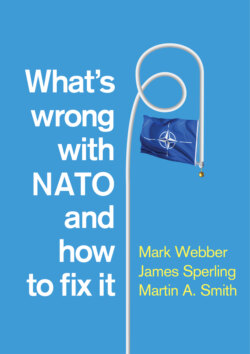What's Wrong with NATO and How to Fix it

Реклама. ООО «ЛитРес», ИНН: 7719571260.
Оглавление
Mark Webber. What's Wrong with NATO and How to Fix it
CONTENTS
Guide
List of Tables
List of Boxes
Pages
What’s wrong? Series
What’s Wrong with NATO and How to Fix It
Preface and Acknowledgements
Notes
Abbreviations
Introduction: What Is Wrong with NATO?
NATO’s Predicament
No, NATO Is Not Finished
NATO is not in terminal decline
NATO is unique
There is no substitute for NATO
NATO is strategically aware
No organization is perfect
In Summary
Notes
CHAPTER ONE Doing Too Much: The Problem of Task Proliferation
Task Proliferation
Strategic Overload
The Roots of the Problem
NATO as an Institution
NATO’s Politics
America’s Foreign Policy Priorities
Liberal Ideas and Liberal Order
NATO’s Treadmill of Problems
Hard Choices
Imprecision
Thin Commitment
Fragmentation
Conclusion: Walking and Chewing Gum
Notes
CHAPTER TWO Weary or Wary? The Problem of American Leadership in NATO
The Transatlantic Bargain: Coming Unstuck Again
The Difficulty of Collective Action
Grand Strategy, American Foreign Policy and NATO
Conclusion: Reluctant and Indispensable
Notes
CHAPTER THREE Fiscal Constraints, Military Capabilities and Burden-Sharing
Defence Spending in an Era of Fiscal Austerity
Military Capabilities and Force Projection Shortfalls
Capabilities
Force Deployment
NATO Military, Stabilization and Reconstruction Operations
Libya
Afghanistan
Conclusion: Learned Helplessness
Notes
CHAPTER FOUR NATO and Russia: Cold War Redux
NATO–Russia Relations in the 1990s
The Permanent Joint Council
The Kosovo crisis
NATO–Russia Relations in the Putin Era
The NATO–Russia Council
The Georgia crisis
The Ukraine crisis
Conclusion: The NATO–Russia Deep Freeze
Notes
CHAPTER FIVE Task Discretion: Doing Less but Better
Matching Means to Ends
The Need for Prudence
NATO’s Need for Strategy
Options for Consolidation
Retreat
Routine
Retrenchment and revival
Conclusion: A Strategic Centre of Gravity
Notes
CHAPTER SIX American Leadership or European Autonomy?
US Leadership and Public Opinion: A Foundation for Optimism
Support for NATO
American leadership
European followership
The Institutional Sources of American Leadership
The Institutional Sources of European Followership
American Foreign Policy: A Jacksonian Ascendancy?
Conclusion: Striking a Viable Transatlantic Bargain
Notes
CHAPTER SEVEN Cash, Capabilities and NATO Effectiveness
Operational Burden-Sharing: A Fair Share?
Measuring the Defence Burden: Shooting at the Right Target
Box 7.1 Alliance contribution rating
Aggregating Capabilities
The NATO Defence Planning Process
Shared capabilities
‘Smart’ capabilities
Working with the EU
‘Clustered’ allies40
Conclusion: Quality or Quantity?
Notes
CHAPTER EIGHT Mending NATO–Russia Relations
Option 1: Enhancing Pan-European Security Structures
Option 2: Russian Membership of NATO
Option 3: ‘Concert’-Type Management of Regional Security in Eastern Europe
Option 4: Reviving the NATO–Russia Council (NRC)
Option 5: Tacit Understandings on Future NATO Enlargement
Conclusion: A Tacit NATO–Russia Security Regime
Notes
Conclusion: Improvement, Repair and NATO’s Future
How to Fix NATO. Task discretion
American leadership
Resourcing, capabilities and operational credibility
Relations with the Russia
What’s Next? Through a Glass, Darkly
Brexit
China
The COVID-19 pandemic
Conclusion: Fixing NATO
Notes
Index
A
B
C
D
E
F
G
H
I
J
K
L
M
N
O
P
Q
R
S
T
U
V
W
Y
Z
POLITY END USER LICENSE AGREEMENT
Отрывок из книги
Paul Harris, What’s Wrong with Climate Politics and How to Fix It
Simon Hix, What’s Wrong with the European Union and How to Fix It
.....
If we accept such views, then NATO would have to be judged against a very low bar, it being just one more flawed and ineffectual international body. Such a starting point would colour both our diagnosis of the problems besetting the Alliance and prescriptions for how to attend to them. We would, in short, steer to a rather limited range of options aware that NATO’s influence in the world was constrained and its future uncertain. Such a view is not without its merits. Indeed, even NATO’s defenders hold to some of its assumptions, not least the view that the Alliance is an arena in which the interests of its members are presented and sometimes collide, and that, ultimately, the US runs the show.
The following chapters demonstrate, however, that such a view is overstated and, in certain regards, inaccurate. The premise we follow in this book is aligned more with the institutionalist view that organizations can have significant effects.30 This does not mean that organizations are detached from their members – far from it. NATO, we suggest, has endured precisely because it serves its members’ interests. It offers ‘value-added’ to the allies in the shape of permanent, tried and trusted military and political cooperation. It goes beyond an alliance of convenience, coordinating defence and security in ways the allies could achieve neither alone nor in temporary coalition.
.....